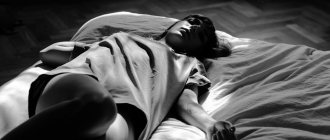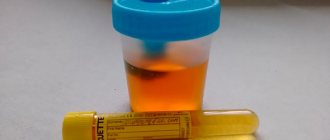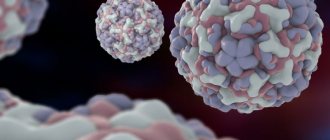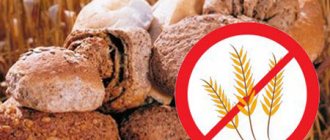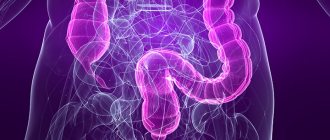Reasons for increasing acetone levels
Acetone is directly related to the process of glucose synthesis. Toxic ketone bodies appear during the breakdown of proteins and fats. It is their level that indicates the presence or absence of acetonemia.
Acetone may appear in the following cases:
- Poor nutrition. The child should eat a balanced diet, eliminating fatty foods full of preservatives and other artificial additives from his diet. Constant overeating or, on the contrary, long periods of hunger will also negatively affect the baby’s health.
- The child’s tendency to be hyperexcitable and under constant stress.
- Excessive physical activity and, as a result, fatigue.
- Infectious diseases and gastrointestinal disorders.
- Diathesis is a disease directly related to blood glucose levels.
Diagnostics
Today, the procedure for determining the level of acetone has been significantly simplified - for this, there are rapid tests that parents can independently purchase at the nearest pharmacy.
The test should be done within three days. The strip is dipped into morning urine, shaken off and after a few minutes you get the result:
- if the initially yellow line on the test turns pink, this indicates the presence of a low level of ketone bodies in the urine;
- if it has acquired a purple tint, it means that the level of acetone in the urine is extremely high and the child requires hospitalization.
Of course, parents should not rely solely on test results - if you suspect acetone, you should urgently contact a pediatrician who will prescribe an examination and tests.
For testing, urine is collected in the morning in a dry and clean container. The norm is when acetone is not detected in the child’s urine. If ketone bodies are present even in small quantities, this is marked in the analysis with “crosses” (pluses). The number of “crosses” indicates the level of ketone bodies in the urine:
- 1 plus indicates a weakly positive result;
- 2-3 pluses means the reaction is clearly positive;
- 4 pluses indicate a pronounced reaction when the child requires immediate treatment.
Symptoms of increased ketone levels in urine
When a child has acetone in his urine, an acetone crisis develops, the symptoms of which are:
- strong odor of acetone from urine, skin and mouth;
- loss of appetite, nausea;
- vomiting four or more times, particularly after eating or drinking;
- dehydration, intoxication, pale skin;
- fever, unhealthy blush;
- signs of damage to the central nervous system - increased excitability, abruptly giving way to apathy, drowsiness, even falling into a coma. In some cases, seizures may occur;
- liver enlargement.
Of course, the acetone crisis will be reflected in the blood test: the biochemical will show acidosis, increased cholesterol levels and a decrease in glucose and chlorides; a general analysis will show a large number of leukocytes and ESR.
You can determine acetonemia at home using special test strips for acetone. They are sold in pharmacies without a prescription. The strip contains an indicator containing reagents that are sensitive to the presence of ketones. The test must be carried out on morning urine, lowering the strip into the container to the specified level. After one minute you can evaluate the result. You will find information on the packaging or instructions on how to determine your ketone concentration level.
The appearance of acetone in the urine of a child
If a child’s acetone level has risen, it is necessary to find the original source of the anomaly.
Where is acetone produced?
Under the influence of various operations, the production of ketone bodies occurs, which are the result of metabolic processes. The elements are formed in the liver in minimal volumes. Carbohydrate foods inhibit the process of their production.
Only with proper and balanced nutrition will ketones in the blood be formed within standard limits. Any deviations provoke their sharp increase.
Reasons for the appearance of acetone in the urine of a child
Ketone bodies are formed in the body due to metabolic disorders. These substances undergo oxidative processes and are excreted through the lungs and urine.
Experts consider the following indicators to be the main reasons for increased levels of acetone in the urine of a small child:
- An incorrectly selected diet - with a predominance of protein and lipid elements that the body is not able to process into glucose. The result of the deviation is the accumulation of necessary components in inventory. In case of emergency, the process of neoglucogenesis is activated - the production of glucose from non-carbohydrate sources.
- Neuro-arthritic diathesis - occurs due to metabolic disorders or is provoked by an incorrect diet.
- Insufficient enzymes - the problem is characterized by poor processing of carbohydrates.
- Lack of glucose in incoming food products - the child’s body suffers without the necessary amounts of carbohydrates.
- Unusual glucose consumption - can be provoked by increased physical, mental, motor activity, or being in a state of constant stress. The rapid processing of carbohydrates is facilitated by trauma, various diseases, and surgical interventions.
- Insulin deficiency - impaired functionality of the thyroid gland signals the onset of diabetes mellitus. The child needs consultation with an endocrinologist and a full diagnostic examination.
The danger of acetone
An increase in the level of the substance is more often recorded in children from one to 13 years of age. Until the first 12 months of life, specialized enzymes are present in the baby’s body that are responsible for processing ketone bodies and obtaining additional energy from them.
In the absence of a negative clinical picture, changes in ketone body levels indicate a physiological basis for the problem, rather than a pathological one. Any manifestation of acetone should be monitored by medical personnel.
A slight change in marks is normal and is not toxic to the body. The first signs of the disease appear in children aged 4 to 5 years; after the 12th birthday, there are no physiological forms of acetonemia. The determination of acetone in urine is a reason to visit a specialist - for the timely detection of diabetes or neoplasm.
Why is acetone in urine dangerous? Ignoring specific symptoms can lead to the development of an acetone crisis. A sign of the disease is a sharp increase in the child’s temperature to 38 degrees, diarrhea, and vomiting. These conditions require calling an emergency team.
Lack of emergency assistance can lead to dehydration, toxic poisoning, central nervous system damage, and coma. The pathology causes complications in the kidneys, liver, joints, and provokes hypertension and diabetes.
Experts distinguish two variants of acetone syndrome:
Primary type - provoked by unknown sources, without negative effects on internal organs. Most children suffering from this type of disease are easily excitable, emotional and irritable. The manifestation of the pathological deviation is insufficient body weight, refusal to eat, disturbances in metabolic processes, insomnia, problems with speech function and the process of urination - a decrease in the amount of urine excreted.
Secondary – other types of illnesses serve as prerequisites for the development of the disease. These include infectious lesions of the intestines, respiratory tract, pathologies of the digestive tract, thyroid and pancreas, kidneys, and liver. The cause of the appearance of acetone in the urine may be diabetes. If its presence is suspected, a blood test is performed to determine the glucose content in the body.
Treatment of acetone syndrome
If a crisis occurs for the first time, you need to call a doctor. Once the cause is determined, treatment will be prescribed, which can be provided at home. First of all, it is necessary to replenish glucose reserves; you can give the child the drug in the form of tablets or sweet drinks: tea with honey, sugar, raisin compote or dried fruits. Drinking promotes the rapid elimination of toxins, so you need to give your child additional water to drink: rice water, boiled water, and mineral water. To cleanse the intestines, an enema with a one percent soda solution is prescribed. Among the medications, Regidron, Enterosgel, Drotaverin, No-shpa can be prescribed. When the child feels the desire to eat, it is necessary to feed him easily digestible food - porridge, puree, liquid soup. You should not allow yourself to feel very hungry.
If the treatment does not have an effect within 24 hours, or vomiting does not stop for 3 hours, call an ambulance!
Increased acetone in the urine is a reason, in addition to standard blood and urine tests, to conduct an examination of the pancreas and liver. When the acetonemic crisis has passed, you should stick to the diet for several days and in the future also monitor the child’s nutrition. Do not allow consumption of carbonated drinks or foods with added preservatives. The child should have a clear daily routine, daily walks. Avoid excessive physical and mental stress.
If acetone in the urine appears every time against the background of infectious diseases, the child must be constantly supplied with additional sources of glucose and monitor the drinking regime.
Treatment of the disease
Prevention of increased acetone is the correct diet, rest and sleep. A different situation arises in the event of a crisis. To avoid complications, it is necessary to restore blood glucose levels as quickly as possible and remove ketone bodies from the body. If acetone increases for the first time, it is better not to self-medicate, but to fly to the hospital or call an ambulance. Before the ambulance arrives, you need to give your child tea with honey at home. The main task of parents is to get their baby drunk. The best option is glucose solution (pharmacy powder + water). If your child is vomiting severely, drinking too much will only make the situation worse. You need to unsolder it gradually - every 5 minutes, 1 tsp. solution. After the acute symptoms have passed, the child can be given sweet tea, alternating it with rice water and mineral water.
It is important that the child drinks not only during the day, but also at night.
Since enterosorbents (Polysorb, Enterosgel) help remove acetone, doctors prescribe a cleansing enema with these drugs. This will help eliminate the symptoms of intoxication. However, it is not recommended to decide on the need for such a procedure on your own; you need to consult a doctor. If the child fails to drink, he will need hospitalization and a drip with glucose solution. As a rule, such measures are necessary only in the most severe cases, when the baby does not stop vomiting, convulsions begin, or there are signs of impaired consciousness (fainting). At the first crisis, it is necessary to establish its cause. To do this, you will need to undergo a detailed examination. Only in this way will the doctor be able to tell how to treat the baby and most effectively remove ketone bodies from the body in order to avoid repeated crises. Treatment during the recovery period consists of a gentle diet, as after food poisoning. Most likely, the child's appetite will be reduced. You should not force feed, but at the same time, you should not allow yourself to go hungry, as this can provoke a repeat attack. The basis of nutrition during this period is vegetables and fruits that have undergone heat treatment, as well as vegetable soups, mashed potatoes or carrots, and baked apples.
Recommendations
Diet for a child with acetonemia:
- Day 1: drink in portions; if there is no vomiting, crackers without salt are suitable.
- Day 2: liquid in portions, rice broth, baked apple.
- Day 3: liquid, crackers, porridge puree.
- Day 4: biscuits or unsalted crackers, rice porridge seasoned with vegetable oil.
In the future, you can include any boiled food and steamed dishes. Includes lean meat, fish, millet and oatmeal. When vomiting returns, they start again with fasting:
- Acetonuria in children periodically manifests itself. If parents have encountered this condition of the baby more than once, constant prevention and control of ketones in the urine will be required.
- It is recommended to reconsider the child’s lifestyle. Frequent walks in the fresh air, outdoor games and little physical activity are necessary.
- The diet should be balanced and contain the right amount of fats and carbohydrates. Protein foods are included daily.
- From childhood it is necessary to accustom oneself to a drinking regime. Drinking the right amount of water per day improves metabolic processes.
If parents follow the doctor's recommendations, the risk of a re-increase in acetone in the urine is significantly reduced. At home, it is recommended to always check for the presence of ketone bodies using a test strip.
You can also watch this video, where Dr. Komarovsky explains the reason for the appearance of acetone in the urine of a child.
Signs and symptoms in children
It is almost impossible to confuse acetonuria with other ailments due to the characteristic pungent odor of acetone from the mouth.
The main symptoms of the disease include:
- poor appetite;
- pain in the navel area;
- profuse vomiting;
- high temperature;
- smell of acetone when urinating;
- bowel disorders.
The child becomes lethargic and apathetic. When he tries to eat, he vomits, which leads to rapid dehydration. The patient's cheeks become crimson.
With acetonuria, disturbances in the activity of the nervous system occur, and heart failure may develop.
In a baby
In infancy, when acetone forms in the urine, the baby becomes whiny and refuses to take the breast or bottle. At the same time, the number of regurgitations after feeding increases.
In children 2-4 years old
Most often, the pathology is observed between the ages of two and four years.
Ketone bodies are formed due to underdevelopment of the pancreas.
It does not produce the amount of enzymes necessary to digest food. Symptoms of the disease occur periodically. The diagnosis of “acetonemic syndrome” is made when the crisis recurs multiple times.
Children with liver failure, prone to allergies, and psychosomatic disorders are at high risk of the appearance of acetone in the urine.
At this age, children quickly become dehydrated.
In a teenager
By adolescence, attacks of the disease usually subside.
But in some children they recur until the age of fourteen. The main cause of the manifestation is neuro-arthritic diathesis. Children with such problems are very emotionally excitable, sometimes ahead of their peers in development.
Usually suffer from underweight. As they age, they develop kidney disease, diabetes, and gout.
Treatment
In most cases, the situation can be stabilized at home. The main goal is to reduce the level of harmful substances in the urine and eliminate the symptoms of intoxication. This requires nutritional adjustments.
Powder for preparing Regidron solution
You can restore the water-salt balance disturbed by vomiting with the help of Regidron. To cleanse the body, Polysorb and Smecta are prescribed. In some cases, antibiotics are prescribed.
It is necessary not only to reduce the level of the substance in urine, but also to identify the cause of the pathology in order to avoid repeated attacks.
Approaches to treating the condition
Elimination of acetonemic crisis
If the symptoms of a crisis appear for the first time, then you need to call your local doctor at home. He will decide whether it is possible to be treated at home or whether hospitalization is necessary. If the symptoms are not very pronounced, then you should immediately try to replenish the sugar supply in the body. To do this, you need to offer your child sweet tea or another drink with honey or sugar, glucose solution or compote. Moreover, drink 1-2 teaspoons every few minutes so as not to cause a gag reflex. To remove excess ketones from the blood and urethra, an enema is given and a course of enterosorbents is prescribed. If the child has developed an appetite, you should give him food that is easy to digest. The drug “Enterofuril” is considered effective in increasing acetone. With its help, ketone is quickly removed from urine and blood.
Treatment of acetone syndrome
After the symptoms of the crisis are relieved, everything possible should be done to prevent the syndrome. If a crisis occurs once, then you need to do all the tests and undergo research to identify the causes. If symptoms recur periodically, then adjustments to the child’s lifestyle and diet are needed. When symptoms of acetonemia accompany every infectious disease, you need to consult a doctor to prevent the problem. It is important to treat with acetone, since neglect of the disease will lead to complications.
Which specialist should I go to?
When the first symptoms of acetonemia appear, you should immediately call your local pediatrician at home. He must examine the child and make a preliminary diagnosis. If the doctor deems it necessary, he will prescribe the necessary laboratory tests. After this, you will need to consult an endocrinologist and gastroenterologist. These highly specialized specialists will carry out the necessary manipulations and make the final diagnosis.
Diet food
If a child has symptoms of acetone in the urine and the diagnosis is confirmed, then you need to immediately switch to dietary nutrition. On the 2nd day after diagnosis, you are allowed to eat a baked apple, homemade crackers or biscuits. Rice water is suitable as a drink. On the 3rd day, you can add mashed potatoes diluted with liquid or rice porridge to the menu. On the 4th day, you should prepare a light vegetable soup. During the week you need to add boiled and chicken meat, oatmeal and kefir to your diet. The diet for acetonemia strictly prohibits smoked foods, fresh fruits and vegetables, chocolate, baked goods, fatty and salty foods, sour cream, store-bought sauces and carbonated water. This diet will help remove acetone from the urine and prevent recurrence.
Causes
The appearance of acetone in the urine and its further increase in children can be associated with various factors:
- Sometimes stress, physical or emotional stress is enough for a child’s body.
- Infectious factors are less common, but are also recorded when a cause associated with an increase in acetone is identified.
- Malnutrition at a young age leads to instability of digestive processes. With excessive consumption of sweets and fats with minimal inclusion of protein dishes, acetonuria develops.
- Fasting, like overeating, also negatively affects metabolic processes. With a severe lack of nutrients, the body uses its last resources. Ketone bodies do not have time to be eliminated from the body.
What are the dangers of acetone crisis and syndrome?
The set of symptoms inherent in a sharp jump in the amount of ketones is called an acetonemic crisis. If this condition of the body is repeated many times, then the child is diagnosed with acetonemic syndrome. Depending on the root cause of the disease, primary and secondary diagnosed syndromes are divided. The first option is stated in the absence of other diseases and problems in the body, except for the increased value of acetone. Secondary syndrome is a consequence of some disease. The most common ailments include diabetes mellitus, various types of infections, influenza, and disorders of the digestive or urinary system. It should be noted that acetonemic syndrome is typical only for children and is associated with the state of their nervous system.

